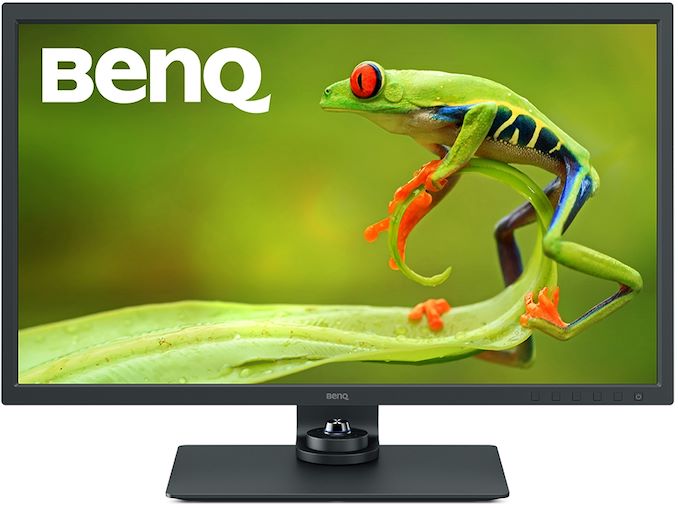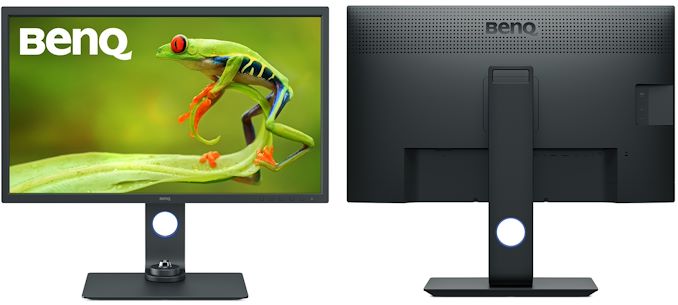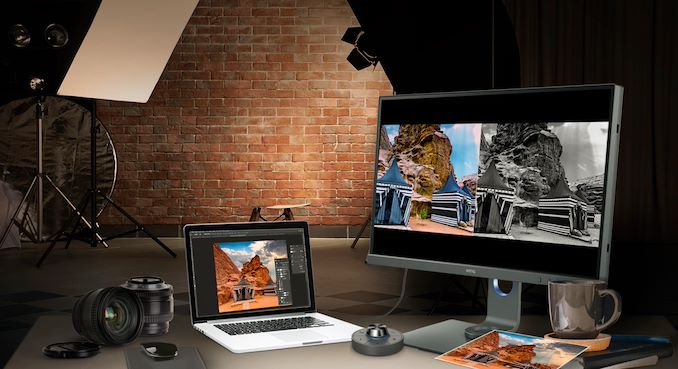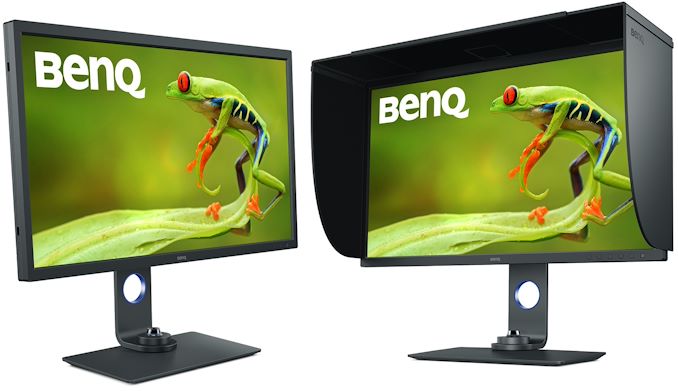BenQ Unveils SW321C: A 32-Inch Pro Monitor with Wide Color Gamuts & USB-C
by Anton Shilov on March 23, 2020 4:00 PM EST
BenQ has introduced a new 32-inch professional-grade display designed for photographers and post-production specialists. Dubbed the SW321C, the monitor is for professionals who need wide color spaces like the Adobe RGB and the DCI-P3, as well as HDR transport support. And, like many other contemporary displays, BenQ’s new LCD is equipped with a USB Type-C input.
Under the hood, the BenQ AQColor SW321C uses a 10-bit 32-inch IPS panel featuring a 3840×2160 resolution, a 250 nits typical brightness, a 1000:1 contrast ratio, a 5 ms GtG response time, a 60 Hz refresh rate, and 178° viewing angles. The monitor uses a LED backlighting that is tailored to ensure brightness uniformity across the whole surface of the screen.
The LCD can display 1.07 billion colors and can reproduce 99% of the Adobe RGB, 95% of the DCI-P3, as well as 100% of the sRGB color gamuts, all of which are widely used by professional photographers as well as video editors and animation designers who do post-production work. Meanwhile, the monitor has a 16-bit 3D LUT (look-up table) and is calibrated to DeltaE ≤ 2 to ensure fine quality of colors and color gradients. The LCD can even display content in different color spaces at the same time side-by-side in PIP/PBP modes.
As for HDR support, things aren't quite as stellar there. The monitor supports HDR10 as well as the relatively uncommon HLG transport format. However the monitor doesn't have the kind of strong backlighting required for HDR, let alone a FALD setup necessary to deliver anything approaching pro-grade HDR. So the inclusion of HDR support seems to be largely for compatibility and checking HDR content, rather than doing actual content editing in HDR.
As far as connectivity is concerned, the display is comes with one DisplayPort 1.4 input, two HDMI 2.0 ports, and a USB Type-C input. The latter can deliver up to 60 W of power to the host, which is enough most laptops. All the connectors support HDCP 2.2 technology that is required for protected content. In addition, the BenQ SW321C monitor has a dual-port USB hub and an SD card reader that is certainly useful for photographers.
Since we are dealing with a professional display, it is naturally equipped with a stand that can adjust height, tilt and swivel as well as work in album mode. In addition, the SW321C comes with BenQ’s hockey puck controller to quickly adjust settings.
| Specifications of the BenQ AQColor SW321C | |
| SW321C | |
| Panel | 32" IPS |
| Native Resolution | 3840 × 2160 |
| Maximum Refresh Rate | 60 Hz |
| Response Time | 5 ms GtG |
| Brightness | 250 cd/m² (typical) |
| Contrast | 1000:1 |
| Viewing Angles | 178°/178° horizontal/vertical |
| HDR | HDR10, HLG |
| Backlighting | LED |
| Pixel Pitch | 0.1845 mm² |
| Pixel Density | 137 ppi |
| Display Colors | 1.07 billion |
| Color Gamut Support | sRGB: 100% DCI-P3: 95% Adobe RGB: 99% |
| Aspect Ratio | 16:9 |
| Stand | adjustable |
| Inputs | 1 × DisplayPort 1.4 2 × HDMI 2.0 1 × USB-C |
| Other | Dual-port USB hub CD Card Reader |
| Launch Date | Spring 2020 |
The BenQ AQColor SW321C monitor is currently listed by BenQ Japan, so expect it to hit the market shortly. Exact pricing is unknown, but this is a professional-grade display, so expect it to be priced accordingly.
Related Reading:















25 Comments
View All Comments
jeremyshaw - Monday, March 23, 2020 - link
SD Card reader: That can actually be pretty useful. I somewhat miss mine, ever since I upgraded from my U2711. Sure, the USB SD card reader I have now is rather neat, and supports microSD without needing another adapter, but it just dangles off my desktop.Location of SD Card reader: Not so useful.
Also, seriously, there is no good reason to not have VRR/Freesync/GSync/AdaptiveSync, etc nowadays. Especially for a monitor that is expected to cost a large amount of money. Even for media consumption, I'd rather not have to deal with pulldowns to get interpreted framerates.
philehidiot - Monday, March 23, 2020 - link
The dingle dangle dongle is only useful if the angle of the dangle gives you the tingle in the dingle. Seriously, it's almost as big a problem as my drinking.umano - Friday, March 27, 2020 - link
I think once the hdr will be mature on professional display at decent pricing (the apple one is not that good) manufacturers will probably improve their photo-editing/graphics design products with 120hz and variable refresh rate technology. At least I hope because now to do all I want to do I need 4 screens and that's insanebug77 - Monday, March 23, 2020 - link
If there's anything professional about this display, the article sure doesn't mention it (besides the LUT).Afaict, this is similar to Dell's U3219Q which can be had rather cheaply. And is brighter, too.
dontlistentome - Monday, March 23, 2020 - link
That Dell is a budget/midrange display. I have one. Resolution: good, but the quality is well below what my u3011 is.dmeerpa - Tuesday, March 24, 2020 - link
depends what you expect under professional ?- hardware calibration : check
- sRGB: 100%, DCI-P3: 95%, Adobe RGB: 99% : check
- Uniformity Technology for Screen-Wide Color Accuracy : check
- Paper Color Sync Technology to Simulate Photo Print Effect on Screen : check
- 16 bit look up table (LUT) : check
- 10bit color input: check
- 10bit panel : check
- Certified with CalMAN Verified AND PANTONE Validated : check
- Shading hood : check
- 4K : check
- DP1.4 : check
brightness is indeed low on paper, but for photography and I guess for other media content, you work between 80 and 120nits, maybe max 140. So is that an issue ?
Tonight I will measure what's the max I get out of the screen.
bug77 - Tuesday, March 24, 2020 - link
Well, I only said the article doesn't do a very good job conveying what's professional about it. Many of the things you listed are not in the article, which is what I was pointing out.And I agree about the max brightness, 120 is where it's at. I just have this HDR itch that makes me look for 600+ ;)
Dug - Tuesday, March 24, 2020 - link
It does check the boxes, I like it.Oxford Guy - Thursday, March 26, 2020 - link
"Meanwhile, the monitor has a 16-bit 3D LUT (look-up table)"Is it programmable?
ValiantEffort - Monday, March 23, 2020 - link
I know it's a strange ask, but with this having USB-C and USB-A and SD reader... an Ethernet port on a monitor like this would be great.Connecting the monitor with a laptop for dual monitor, power, and network connection. Even if it is a bit more expensive. Rather than a separate USB-C dock that has Ethernet, USB-A, and SD reader ports.
Just a thought. Maybe the monitor I described exists, and I haven't discovered it yet.